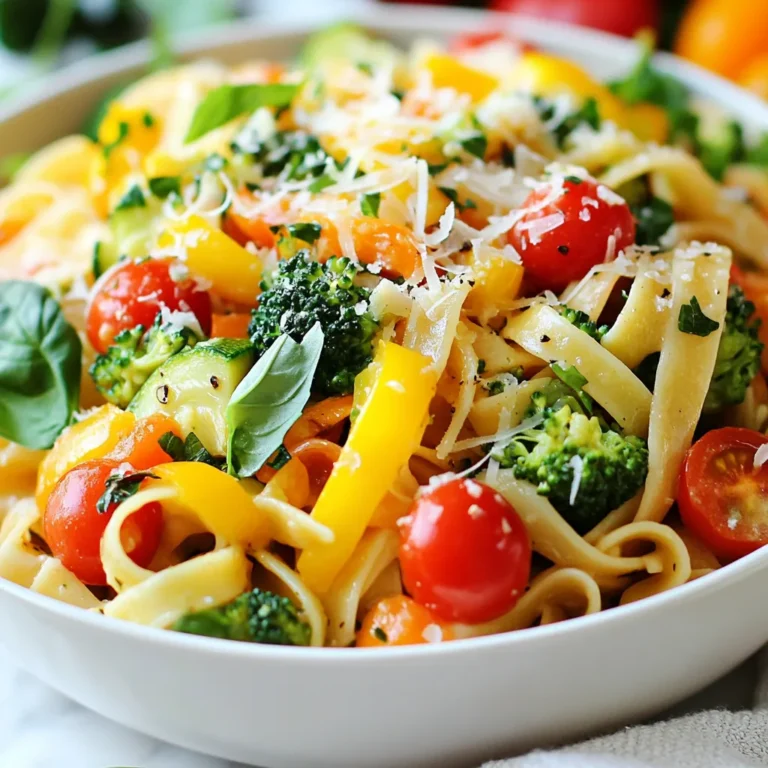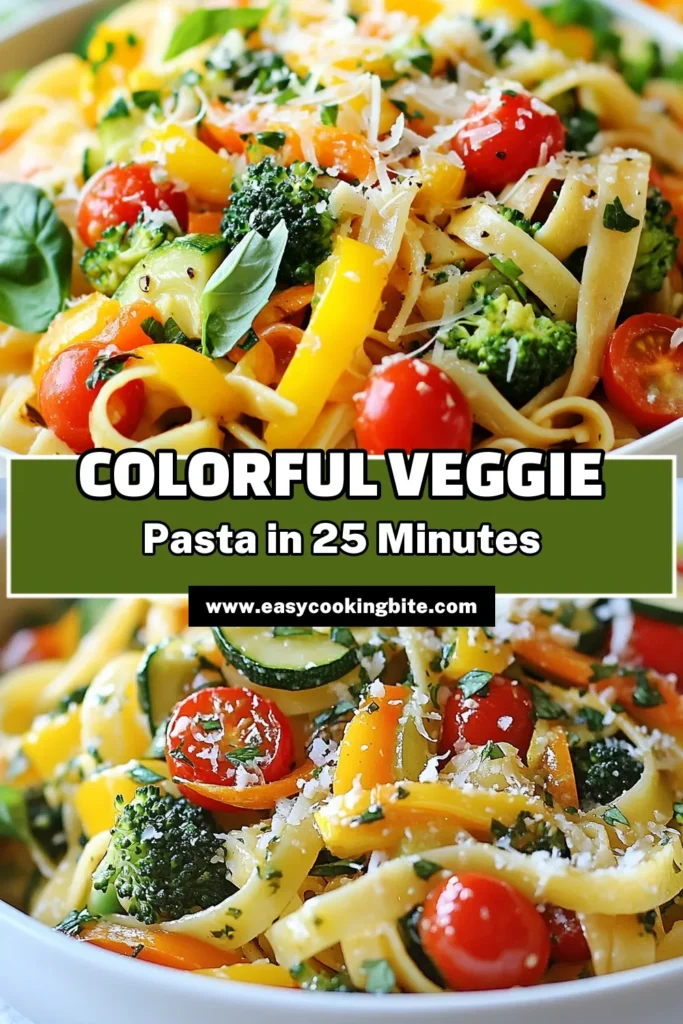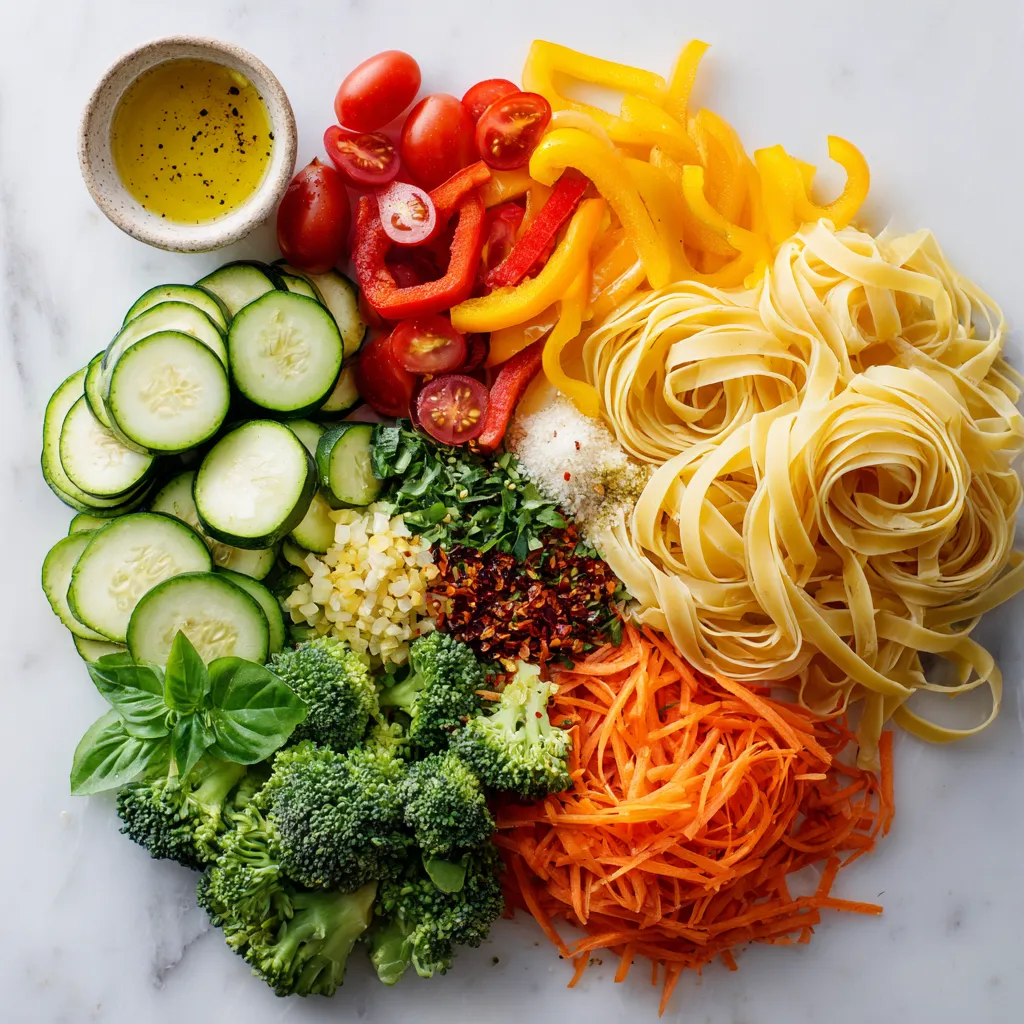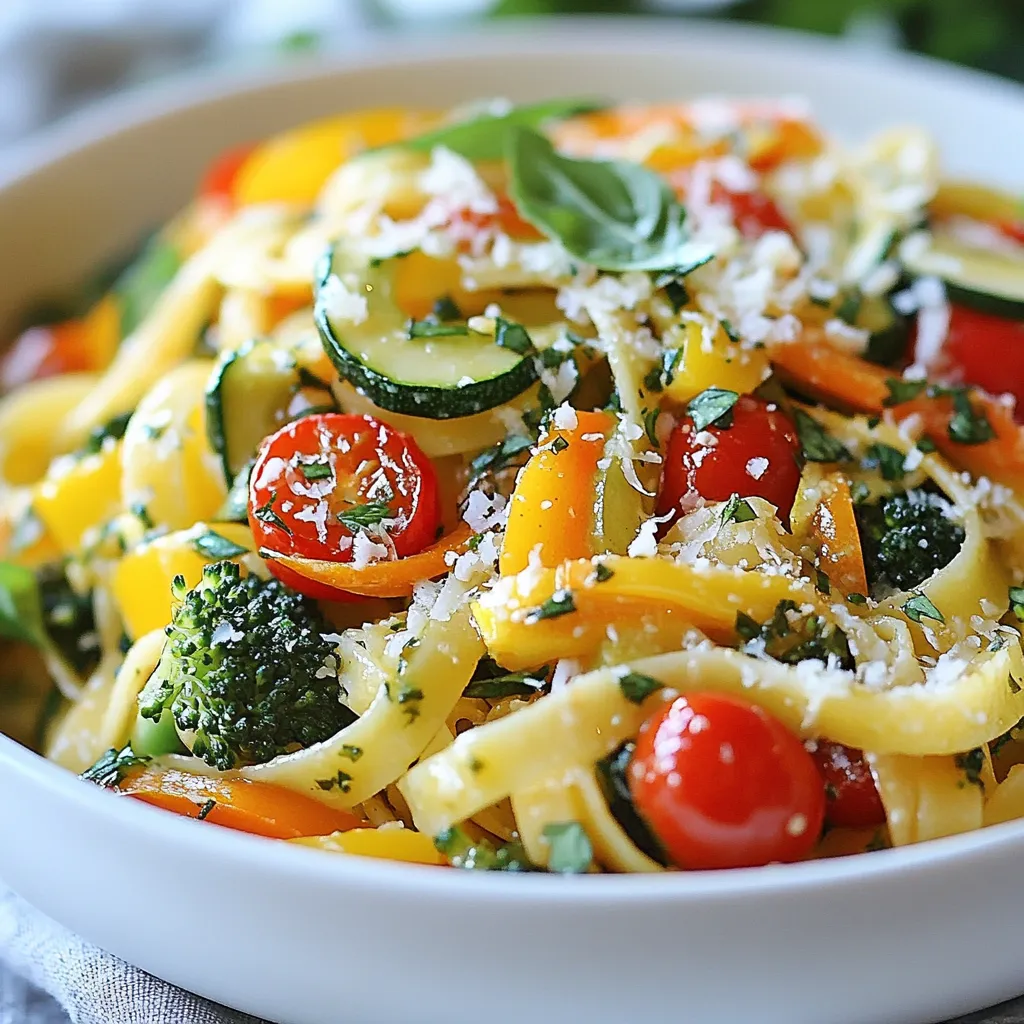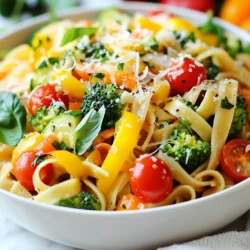WANT TO SAVE THIS RECIPE?
Looking for a quick, tasty dinner? Pasta Primavera is here to save your night! This dish combines fresh veggies with al dente pasta for a colorful, easy meal. You can make it your own with just a few simple swaps. Join me as I share the ingredients, step-by-step instructions, and handy tips to create a Pasta Primavera that will impress your family and friends. Let’s dive in!
Why I Love This Recipe
- Fresh and Colorful: This pasta primavera is bursting with vibrant vegetables that not only look appealing but also provide a variety of nutrients.
- Quick and Easy: With a total preparation and cooking time of just 25 minutes, this dish is perfect for busy weeknights.
- Customizable: You can easily swap out vegetables based on what you have on hand or your personal preferences, making it versatile.
- Deliciously Flavorful: The combination of garlic, fresh basil, and Parmesan cheese adds an irresistible flavor that elevates this simple dish.
Ingredients
Main Ingredients for Pasta Primavera
– 8 oz fettuccine or spaghetti
– 2 tablespoons olive oil
– 1 small zucchini, sliced
– 1 bell pepper (any color), sliced
– 1 cup cherry tomatoes, halved
– 1 cup broccoli florets
– 1 carrot, julienned
– 2 cloves garlic, minced
– 1 teaspoon dried oregano
– 1 teaspoon red pepper flakes (optional)
– 1/4 cup fresh basil, chopped
– Salt and pepper, to taste
– Freshly grated Parmesan cheese (optional, for serving)
These ingredients create a colorful and tasty dish. The pasta serves as a base. The veggies add crunch and flavor. Olive oil provides a rich, smooth taste. Garlic gives it a nice aroma and kick.
Optional Ingredients for Customization
– Extra vegetables like asparagus or spinach
– Protein options such as grilled chicken or shrimp
– Crushed nuts for added texture
– Fresh herbs like parsley or thyme
– Balsamic vinegar for tangy flavor
Feel free to mix and match these additions. This way, you can make the dish your own. Adding your favorite veggies can change the taste and look.
Recommended Cooking Tools
– Large pot for boiling pasta
– Skillet for sautéing vegetables
– Cutting board for chopping
– Sharp knife for slicing
– Colander for draining pasta
Using the right tools makes cooking easier. A large pot holds enough water for the pasta. A good skillet helps cook the veggies quickly. A sharp knife speeds up your prep time.

Step-by-Step Instructions
Cooking the Pasta
To start, grab a large pot. Fill it with water and add salt. Bring the water to a boil. Once boiling, add your fettuccine or spaghetti. Cook it until it’s al dente, which takes about 8 to 10 minutes. After cooking, drain the pasta. Save about 1/2 cup of that pasta water for later. Set the pasta aside while you prepare the veggies.
Sautéing the Vegetables
Now, take a large skillet and heat 2 tablespoons of olive oil over medium heat. Add the sliced zucchini, bell pepper, broccoli florets, and julienned carrot. Toss in 2 minced garlic cloves too. Sauté the mix for about 5-7 minutes. You want the veggies tender but still bright and colorful. This step brings out their flavors.
Next, add 1 cup of halved cherry tomatoes. Sprinkle in 1 teaspoon of dried oregano and, if you like it spicy, add 1 teaspoon of red pepper flakes. Cook this mixture for another 2-3 minutes. You want the tomatoes to soften just a bit.
Combining Ingredients and Serving
Add the cooked pasta to your skillet with the veggies. If the mix looks dry, pour in some reserved pasta water to help. Toss everything together over low heat for about 2 minutes. This lets the flavors blend nicely.
Finally, take it off the heat and stir in 1/4 cup of fresh basil. Season with salt and pepper to taste. Serve the pasta primavera in bowls. If you want, top it with freshly grated Parmesan cheese and a few basil leaves for a beautiful touch. Enjoy!
Tips & Tricks
How to Achieve Perfectly Cooked Pasta
To cook pasta perfectly, use a large pot. Fill it with water and add salt. Bring the water to a rolling boil before adding your pasta. For fettuccine or spaghetti, cook for about 8-10 minutes. Check the package for exact times. Test for al dente by tasting a piece. You want it firm but not hard. Save half a cup of the pasta water. This water helps mix with your sauce later.
Best Practices for Sautéing Vegetables
Always start with hot oil in your pan. Use medium heat to keep the oil from smoking. Add your tougher veggies first, like carrots and broccoli. Cook them for about 3-4 minutes. Then, add softer veggies, such as zucchini and bell peppers. Stir often to keep them from burning. Add garlic near the end, so it doesn’t burn. You want the vegetables colorful and tender, not mushy.
Flavor Enhancements and Seasoning Suggestions
Enhance your Pasta Primavera with herbs and spices. Dried oregano adds a nice touch. If you like heat, sprinkle in red pepper flakes. Fresh basil gives a burst of flavor. Don’t forget to season with salt and pepper. For a rich finish, top with grated Parmesan cheese. It melts beautifully over the warm pasta. Always taste as you go to find the right balance.
Pro Tips
- Use Fresh Vegetables: For the best flavor and texture, choose fresh, in-season vegetables. They not only taste better but also add vibrant colors to your dish.
- Reserve Pasta Water: Always save a cup of pasta water before draining. This starchy water is perfect for adjusting the sauce consistency and helps the sauce adhere to the pasta.
- Customize Your Veggies: Feel free to swap in your favorite vegetables or whatever you have on hand. Asparagus, peas, or spinach are great alternatives for this primavera.
- Add Protein: If you want to make the dish more filling, consider adding grilled chicken, shrimp, or chickpeas for a protein boost.

Variations
Vegetarian and Vegan Alternatives
Pasta Primavera is a great dish for everyone. To make it vegetarian, just skip the cheese. For a vegan version, use nutritional yeast instead of Parmesan. You can also add more veggies. Think about mushrooms, spinach, or asparagus. They add great flavor and color.
Protein Additions (Chicken, Shrimp, Tofu)
Want to add some protein? Chicken works well. Just cook it in the skillet first. Then, add the veggies. Shrimp is another tasty choice. Sauté them until they turn pink. Tofu is great for a vegan option. Use firm tofu and sauté it until golden. Each option boosts the dish’s heartiness.
Gluten-Free Pasta Options
If you need gluten-free pasta, there are many choices. Look for brown rice or chickpea pasta. These options taste great and hold up well. Cook them as you would regular pasta. This way, everyone can enjoy Pasta Primavera, no matter their diet.
Storage Info
How to Store Leftover Pasta Primavera
To store leftover pasta primavera, let it cool first. Place it in an airtight container. Make sure to seal it well. Store it in the fridge for up to three days. If you have extra sauce, store it separately. This keeps the pasta from getting mushy.
Reheating Instructions
When you are ready to eat your leftovers, take them out of the fridge. You can reheat pasta primavera in a microwave or on the stove. If using a microwave, place it in a bowl and cover it with a lid. Heat it for about 1-2 minutes. Stir halfway through for even heating. On the stove, add a splash of olive oil in a pan. Heat on low and stir for about 5 minutes. This keeps it fresh and tasty.
Freezing Tips and Best Practices
If you want to freeze pasta primavera, use a freezer-safe container. It can stay frozen for up to two months. Make sure to leave some space in the container for expansion. When you are ready to eat, thaw it overnight in the fridge. Reheat as mentioned above. Freezing works best if you leave out the fresh basil and cheese. Add them back in when you serve it.
FAQs
What is Pasta Primavera?
Pasta Primavera is a bright and fresh dish. It features pasta and seasonal vegetables. The name means “spring pasta” in Italian. This dish celebrates vibrant flavors and colors. You can use any pasta type like fettuccine or spaghetti. The main veggies include zucchini, bell peppers, cherry tomatoes, and broccoli. Each bite is a taste of spring.
Can I prepare Pasta Primavera ahead of time?
Yes, you can prepare Pasta Primavera ahead of time. Cook the pasta and veggies separately. Let them cool and store in the fridge. When ready to eat, just reheat them together in a pan. Add a splash of reserved pasta water to keep it moist. This way, you save time on busy nights.
What vegetables work best in Pasta Primavera?
You can use many vegetables for Pasta Primavera. Good choices include:
– Zucchini
– Bell peppers
– Cherry tomatoes
– Broccoli
– Carrots
– Asparagus
– Peas
Feel free to mix and match. Pick what you like or what’s in season. Fresh veggies add great color and flavor.
How do I make Pasta Primavera creamy?
To make your Pasta Primavera creamy, you can add a few simple ingredients. After cooking the pasta, save some pasta water. Gradually mix it in while tossing everything together. You can also add cheese like Parmesan for richness. Another option is to use cream or a splash of milk. This will give you a smooth and tasty sauce.
This blog covers all you need for Pasta Primavera. We discussed main and optional ingredients, plus tools to use. You learned the steps for cooking and mixing the dish. Tips on cooking pasta and sautéing veggies will help you succeed. We explored tasty variations to fit your diet. Lastly, we provided storage tips for leftovers and answers to common questions.
Now, you can enjoy making your Pasta Primavera just how you like it. Happy cookin
Vibrant Vegetable Pasta Primavera
A colorful and healthy pasta dish loaded with fresh vegetables.
Prep Time 15 minutes mins
Cook Time 10 minutes mins
Total Time 25 minutes mins
Course Main Course
Cuisine Italian
- 8 oz fettuccine or spaghetti
- 2 tablespoons olive oil
- 1 small zucchini, sliced
- 1 bell pepper any color, sliced
- 1 cup cherry tomatoes, halved
- 1 cup broccoli florets
- 1 carrot julienned
- 2 cloves garlic, minced
- 1 teaspoon dried oregano
- 1 teaspoon red pepper flakes (optional)
- 0.25 cup fresh basil, chopped
- to taste salt and pepper
- optional freshly grated Parmesan cheese for serving
Cook the Pasta: Bring a large pot of salted water to a boil. Add the fettuccine and cook according to package instructions until al dente. Drain and set aside, reserving about 1/2 cup of pasta water.
Sauté the Vegetables: In a large skillet, heat the olive oil over medium heat. Add the zucchini, bell pepper, broccoli, carrot, and garlic. Sauté for about 5-7 minutes or until the vegetables are tender but still vibrant in color.
Add Tomatoes and Seasonings: Stir in the cherry tomatoes, dried oregano, and red pepper flakes (if using). Cook for an additional 2-3 minutes until the tomatoes begin to soften.
Combine with Pasta: Add the cooked pasta to the skillet with the vegetables. If necessary, add some reserved pasta water to achieve the desired consistency and creaminess. Toss everything together over low heat, allowing the flavors to meld for about 2 minutes.
Finish and Serve: Remove from heat, stir in the fresh basil, and season with salt and pepper to taste.
Plating: Serve the pasta primavera in bowls. Optionally, top with freshly grated Parmesan cheese and a few extra basil leaves for garnish.
Feel free to customize the vegetables based on your preference.
Keyword healthy, pasta, primavera, quick, vegetables
WANT TO SAVE THIS RECIPE?
